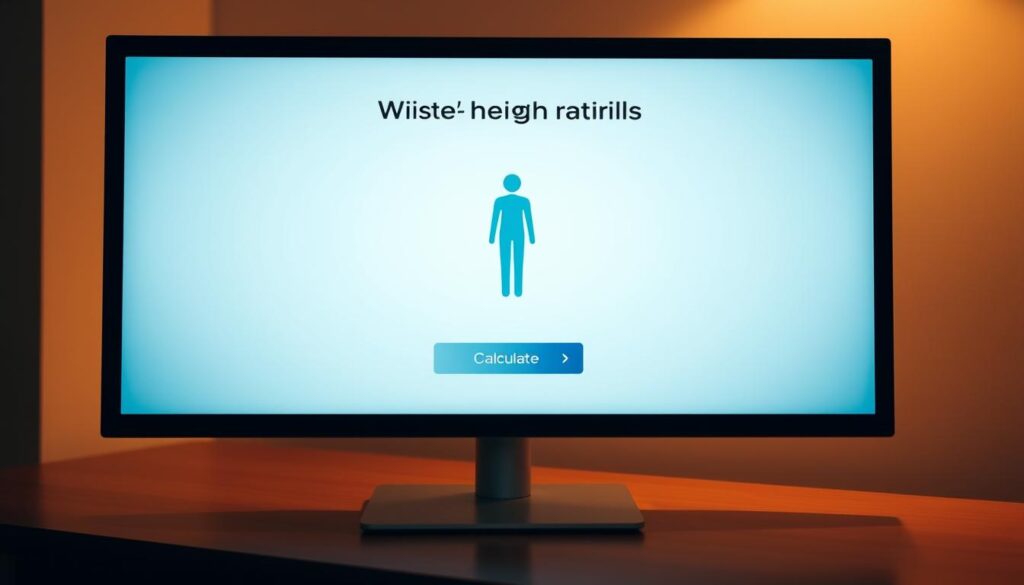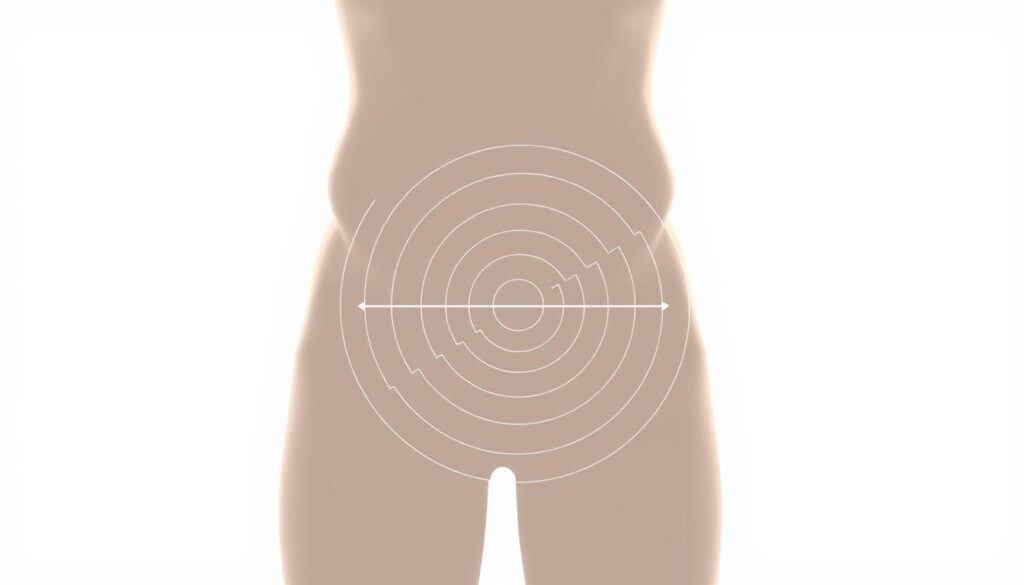Do you know the dangers of too much belly fat? Centralized obesity can lead to serious health issues. Knowing your waist-to-height ratio is key to spotting these risks.
Introducing the Waist-to-Height Ratio Calculator. It’s a simple tool that shows your waist-to-height ratio. This ratio tells you about your health risks.
With our calculator, you can find your waist-to-height ratio. It’s a simple way to start managing your health. It helps you see the dangers of too much belly fat.
Key Takeaways
- Understand the significance of waist-to-height ratio in assessing health risks.
- Learn how to use the Waist-to-Height Ratio Calculator effectively.
- Discover the importance of monitoring your waist measurement.
- Take the first step towards managing health risks associated with centralized obesity.
- Use our calculator for an easy and accurate assessment.
Understanding Waist-to-Height Ratio: What It Is and Why It Matters
Knowing about waist-to-height ratio is key to spotting health risks tied to body fat. This simple measure is popular for its ease and effectiveness. We’ll explore what it is, why it’s important, and how it stacks up against other health checks.
Definition of Waist-to-Height Ratio
The waist-to-height ratio is found by dividing your waist size by your height. This simple formula quickly shows if your waist size is healthy compared to your height. A ratio of 0.5 or less is usually seen as healthy.
To figure out your waist-to-height ratio, measure your waist at its narrowest point, just above your belly button. Then, divide that by your height in the same units (like centimeters or inches). The waist to height ratio formula is just Waist Circumference / Height.

Importance of Calculating This Ratio
Figuring out your waist-to-height ratio is important. It’s a good sign of health risks, like heart disease and diabetes. Research shows people with a higher ratio face a higher risk of these conditions.
One big plus of using the waist-to-height ratio is it gives a more detailed look at health than just weight or BMI. It focuses on where body fat is, which is key to health risks.
- Helps in assessing visceral fat
- Predicts cardiometabolic risks
- Offers a simple and effective health assessment tool
How It Compares to Other Measurements
Comparing waist-to-height ratio to other health measures like BMI waist to height shows each has its own strengths. BMI uses a different formula (weight in kg / height in meters squared) and doesn’t measure body fat distribution.
The waist-to-height ratio, though, directly looks at central obesity, a big risk factor for health problems. While a body mass index calculator tells if your weight is healthy for your height, it doesn’t consider muscle or fat spread.
- Waist-to-height ratio is more indicative of visceral fat.
- BMI provides a general indication of whether your weight is appropriate for your height.
- Using both metrics together can offer a more comprehensive view of health.
How to Use Our Waist-to-Height Ratio Calculator
Our Waist-to-Height Ratio Calculator is easy to use. Just follow a few simple steps. It’s designed to help you understand your health metrics.
Step-by-Step Guide to Inputting Your Measurements
To start, you need to enter two measurements: your waist and height. Here’s how:
- Waist Circumference: Measure around your natural waistline, the narrowest part of your torso.
- Height: Enter your height in the units you prefer (e.g., centimeters or inches).
After entering these, our calculator will show your Waist-to-Height Ratio.
Interpreting the Results
The Waist-to-Height Ratio is a simple yet effective health indicator. For adults, a ratio above 0.5 may suggest increased health risks. You can check a waist height ratio chart to see how you compare to health guidelines.
Key Features of Our Calculator
Our Waist-to-Height Ratio Calculator has several key features:
| Feature | Description |
|---|---|
| Easy Input | Simple interface for inputting waist circumference and height. |
| Accurate Calculation | Provides precise Waist-to-Height Ratio based on your inputs. |
| Health Risk Indication | Compares your ratio with standard health guidelines to indicate potential risks. |
Using our calculator can help you understand your health better. It can guide you in maintaining a healthy weight and reducing health risks.

The Health Implications of Waist-to-Height Ratio
The waist-to-height ratio is key to our health, mainly for heart disease risks. An unbalanced ratio can lead to many health problems. It’s a vital measure for health checks.

Associated Health Risks of an Imbalanced Ratio
An unbalanced waist-to-height ratio raises the risk of heart attacks, strokes, and high blood pressure. Excess fat around the waistline is risky because it’s visceral fat. This fat surrounds vital organs and increases health risks.
Also, a high waist-to-height ratio is linked to metabolic syndrome. This is a group of conditions that raise the risk of type 2 diabetes and heart disease. Knowing how to calculate the waist to height ratio can help understand these risks.
Waist-to-Height Ratio vs. Body Mass Index (BMI)
BMI is used to check body fat, but it doesn’t show fat distribution. The waist-to-height ratio, on the other hand, looks at fat distribution. It gives a clearer view of health risks.
To calculate waist to height ratio, just divide your waist size by your height. This simple step gives a better look at health risks than BMI alone. It’s important when looking at the BMI waist to height connection.
Benefits of Maintaining a Healthy Ratio
Keeping a healthy waist-to-height ratio is vital for heart disease prevention and other health issues. It helps lower the risk of serious health problems.
Also, achieving a healthy waist-to-height ratio means making lifestyle changes. This includes eating well and exercising regularly. These changes have many health benefits. Focusing on a healthy ratio helps take a holistic approach to health and well-being.
Visualization Tools: Infographics for Better Understanding
Infographics are a great way to show why keeping a healthy waist-to-height ratio is important. They help us see the data clearly and make smart health choices.
Healthy Ratio Ranges Explained
Knowing what a healthy waist-to-height ratio is is key. A ratio of 0.5 or less is usually good. But, it can change a bit for men and women, and with age. Our waist height ratio chart makes these ranges easy to see.
The chart shows how waist-to-height ratio affects health risk. For example, a ratio between 0.5 and 0.6 might mean a higher risk of health problems. And a ratio over 0.6 is often linked to a much higher risk.
Health Risks Linked to Different Ratios
Each waist-to-height ratio comes with its own health risks. A higher ratio can mean a bigger chance of heart disease, diabetes, and some cancers. Our infographic on health risks gives a detailed look:
- Low Risk: Ratio ≤ 0.5
- Moderate Risk: Ratio between 0.5 and 0.6
- High Risk: Ratio ≥ 0.6
Using online health calculators and our healthy weight calculator, you can check your waist-to-height ratio. This helps you understand your health risks.
Keeping a healthy waist-to-height ratio is crucial for avoiding many health problems. Infographics make it easier to grasp and manage our health.
Tips for Maintaining a Healthy Waist-to-Height Ratio
Keeping a healthy waist-to-height ratio is key for your well-being. Simple lifestyle changes can help you achieve and keep a healthy ratio. Use a waist measurement calculator to track your progress.
Diet and Exercise
A balanced diet and regular exercise are crucial. Adding physical activity to your day helps you reach a healthy weight. Use a healthy weight calculator to see your progress.
Monitoring Progress
It’s important to regularly track your waist-to-height ratio. A body mass index calculator can help you see how your ratio compares to your BMI.
Professional Guidance
If keeping a healthy waist-to-height ratio is hard, get help from a healthcare professional. They can give you personalized advice and help you create a plan that fits your needs.


